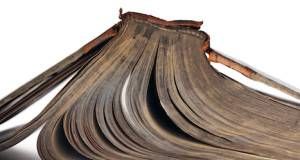
How to Fix Book Binding: Say Goodbye to Loose Pages and Broken Spines
In a perfect world, books would stay in pristine condition from the moment they were created until, well, forever. Unfortunately, if you’re a reader like me who takes their books out into the world, you will likely need some type of book repair in your life. We’ve covered how to save a wet book. We’ve covered how to clean books. Now we’re here to teach you how to fix book binding.
Do You Need to Fix Book Binding? Don’t Do This!
Hopefully, you have found this article before you’ve gone rogue and started with some seemingly apparent options. For example, tape is a great option, right? Glue sticks have saved billions of craft mishaps over the years, and rubber cement is there forever, as evidenced by the rubber cement that was spilled on a fire hydrant near my elementary school and remained there for at least four years. So these would all be great options right? Wrong.
All of these can cause severe damage to your books. They may be fine if you’re trying to keep a few pages in order until the semester’s over and you can recycle the book, but they are not an answer to how to fix book binding.
How to Fix Book Binding: Loose Pages Edition
There are several ways in which your broken book binding can lead to issues, including loose pages. If this is your problem, the following steps should be your solution:
1. Get the Right Products
For the best results with any type of DIY book repair, you need book or binding glue. Acid-free glue is a must because any acid in the glue will eventually eat away at the spine of your book. You can find acid-free options (including those made specifically for books or binding) at your local craft store, book binding store, or the world wide web.
You’ll also need some type of long stick. A bone folder will work, if you’re a nerd like me that has extra bone folders around, or a popsicle stick, or even a knitting needle. These will be used to help spread the glue to ensure it’s evenly applied.
Finally, you’ll need a bunch of heavy books. I know this will be hard for most of our readers, who only have a single book and it’s broken and they’re trying to figure out how to fix the book binding, but you now have our permission to buy several heavy books. You’re welcome!
2. Set the Loose Pages Aside
You will need to remove the loose pages carefully. Then set them aside in a safe space where they will not come into contact with the glue. Keep them in the correct order so that you do not glue them back in out of order.
3. Apply Your Glue
Now, apply the glue. Open your book and squeeze a thin layer of glue inside the spine of the book where the pages have loosened. Then use your bone folder/popsicle stick/knitting needle to spread the glue. The goal is to have an even, thin layer of glue on the spine.
4. Stick Your Pages Back on the Spine
Once again: Make sure they are in the right order! Then line up your pages on both the top and bottom to ensure they are even with the other pages. Press firmly on the edges to set your pages into the spine. Do what you need to do so to get the pages to line up with the rest of the book but remember that you don’t have unlimited time—the glue will dry.
5. Add Some Heavy Stuff and Let the Book Dry
Now close up the book, put a whole host of heavy books on top of it, and let it dry for at least 24 hours. When you open it, you should have a book that has tightly attached pages.
How to Fix Book Binding: Broken Hinge Edition
If your hinge is broken, or nearly broken, then you’ve got a few different steps to follow if you want to learn how to fix a book spine. First and foremost, you need to remove the hinge from the book entirely. We know this sounds counterintuitive but trust us, it is easier to repair a hinge that is removed than one that is clinging to the book. Then grab your scissors and trim away any loose paper or threads. Now you’re ready to get started.
1. Gather Supplies
You will need single-stitched binder tape for this job. This can be found in most craft stores. You’ll need non-acid adhesive and brushes to apply said adhesive evenly. Grab some waxed paper. Finally, get at least two large rubber bands.
2. Cut Your Binder Tape
Cut a piece of binder tape that is the same height as the text block. Why not use the height of the book cover? Because the text block is almost always shorter and if you base your measurement on the book cover, you are likely to end up with way too much tape.
3. Brush One Side of the Tape with Adhesive and Attach the Tape to the Text Block
Carefully and evenly apply adhesive to one side of the tape and then attach it to the text block and spine. Make sure you’re holding the tape by its dry tabs and lining up the stitching with the edge of the text block. One tab with adhesive should be stuck to the first page of the text block while the other should be applied to the spine of the text block. Then find a flat item and use it to rub the tape so it sticks firmly.
4. Give the Adhesive Plenty of Time to Dry
This can take a few hours or it can take all night. You will be able to tell the adhesive is dry by running your finger over the top. Does it feel wet at any point? Then it is not dry enough to move on to the next step.
5. Place Your Waxed Paper
Take your waxed paper and place it on top of the text block while also in the spine. It should be on top of the binder tape you’ve glued into the book and under the binder tape that has not yet been glued. Then apply adhesive to the two tabs, gently bring up the cover so the edge of it fits along the seam of the tape, and press the spine against one tab. You can tell you have done this correctly if you pull the cover up and the spine lays flat against the tab.
6. Attach the Final Tab to the Cover
Now you should attach the final tab to the cover of the book, smooth it with a flat object so that it is lying flat against the cover, and then close the book. Run your flat piece along the spine to make double-sure that the tabs are sticking to the spine.
7. Keep the Book Tight with Rubber Bands and Let it Dry Overnight
Grab your larger rubber bands, use them to secure the book, and let the whole thing dry overnight. The bands can help ensure that the adhesive is drying evenly and that the tabs are laying flat against both the text block and the spine. Once it is dry, take off the rubber bands, remove the waxed paper, and open your book carefully so that it has time to acclimate to the repair.
If the pages are slightly uneven, use sandpaper to even them out.















